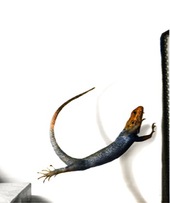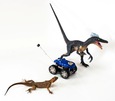Highlight
Leaping Lizards, Robots and Dinos Tell a Tale of Tails
Achievement/Results
Graduate student Evan Chang-Sui, Principal Investigator Robert Full and their team of biologists and engineers from the University of California at Berkeley tested a forty-year old hypothesis proposed by a paleontologist to explain how dinosaurs used their tails. Support by a National Science Foundation-sponsored Integrative Graduate Education and Research Traineeship (IGERT) in Bio- and Bio-inspired Motion Systems Operating in Complex Environments provided the unique interdisciplinary learning experience where it became possible. Discovering that leaping lizards use their tail to balance their body led to the development of a novel robot, Tailbot, that serves as a prototype for the next generation of agile, mobile search-and-rescue robots.
The IGERT team’s discovery was the cover story for the biological journal, Nature, received an award as a finalist for the best paper at the Intelligent Robotics and Systems (IROS) 2011 engineering conference, received honorable mention for a poster at the Society of Integrative and Comparative Biology Meeting, and highlighted the IGERT’s synergy between teaching and research, as the study originated in the core IGERT discover-based learning laboratory.
Leaping African, red-headed lizards control tumbling by careful swings of their tails. Testing a 40 year old hypothesis first proposed for dinosaurs like those of Jurassic Park fame, lizards ran down a track, vaulted off an obstacle, as in the Olympics, but instead of landing on the ground, they leapt to a vertical surface with a shelter on top. When the friction on the obstacle was reduced, lizards slipped, potentially causing their body to spin out of control. Using high-speed videography and motion capture, researchers noticed that the rotation of their body appeared to be just counteracted by the swing of their tail up or down, keeping them stable.
To see if the tail was actively stabilizing the lizard’s body in mid-air, researchers used a control theoretic framework from engineering. To do this, they gathered together an interdisciplinary team of biologists and engineers. To quantify their observations, they built both mathematical and physical models. The lizard-sized, physical model took the form of a robot car with an active tail they named Tailbot. With no feedback from sensors about body position, the robot took a nose-dive when driven off a ramp that mimicked the lizard’s take-off. However, when body attitude was sensed and fed back to the tail motor, Tailbot’s body was stabilized by redirecting the angular momentum of the body into the swing of the tail, just like the leaping lizards.
Tailbot wasn’t only a model for biology, it also pushed the boundaries of control in robotics in a new area termed Inertial Assisted Control (IAC). The interdisciplinary research team took the next step by developing the robot’s ability to use its tail on the ground to simplify control over rough terrain. Now the team is returning the inspiration by suggesting new hypotheses for the control of running by swinging tails and preliminary results are promising. Inspiration from lizard tails will likely lead to far more agile search-and-rescue robots, as well as having greater capability to more rapidly detect chemical, biological or nuclear hazards.
Returning to the original hypothesis on theropod dinosaurs, researchers modeled Velociraptor and showed that muscles willing, the dinosaur could be even more effective with a swing of its tail in controlling body attitude than the lizards. Did they makers of Jurassic Park get it right when they animated the agile Velociraptors? At least in one scene, the Velociraptor swings its tail up to prevent a pitch down, so that it may land on the T. rex skeleton that the actors are hanging onto.
Address Goals
Discovery. The goal of UC Berkeley’s Center for interdisciplinary Biological-inspiration in Education and Research (CiBER) IGERT is to train biology and engineering PhD students how to develop mutualistic teams that energize transformative, interdisciplinary, basic research and translate fundamental discoveries into societal benefits. Current challenges in science, engineering, industry and society demand research-based skills as well as the ability to collaborate on diverse, interdisciplinary teams, but this is seldom taught explicitly. Our training program in Bio-inspired Motion Systems Operating in Complex Environments focuses on interdisciplinary collaboration in an effort to translate biological discoveries into engineered devices, and to apply new engineering approaches to generate hypotheses and tools for biological research.
The discovery of inertial assisted control inspired by the function of tails in lizards shows how an interdisciplinary approach can both advance the frontiers of knowledge and accelerate the translation towards a novel engineering device that can benefit society. Only through the unique combination of biologists, paleontologists, roboticists, mechanical and control engineers, could the present discovery have been made. Each group contributed knowledge and expertise so that the collective discovery was beyond what any single group could have imagined. Paleontologists provided the original hypothesis. Biologists found the best model organism, the African red headed lizard, and designed the experiments to test the hypothesis of inertial stabilization by a tail. Mechanical and control engineers built the physical model, the robot – Tailbot, to test the biological hypotheses and to provide a prototype for a robot. Roboticists will now be able to translate the inspiration from nature toward design a far more maneuverable search and rescue robots that will be able to save human lives directly or in disasters such as earthquakes, tornadoes, and explosions or by rapid detection of chemical, biological or nuclear hazards.
Learning. Notable is the fact that the study began in a research-based teaching laboratory housed in Berkeley’s Center for interdisciplinary Bio-inspiration in Education and Research (CiBER). CiBER’s mission is to facilitate a mutualism where research-based teaching leads to better learning and where interdisciplinary teaching leads to better research. Teams of biologists and engineers composed of both undergraduates and graduate students use state-of-the-art research equipment in the teaching laboratory each week with the opportunity to approach original discovery in areas of biomechanics that include neural control, muscle function, materials testing, energetics, hydrodynamics and aerodynamics. The goal of the final project is to make a novel discovery, present it at a meeting and publish the results. The present study is one such final project and includes one undergraduate bioengineer, two undergraduate and one graduate student from biology and two mechanical engineering graduate students along with the senior investigator.
IGERT support has allowed us to develop a discovery-based learning approach that can serve as a model to be replicated elsewhere. In the move away from content driven memorization to “flipping the classroom” toward active learning, the CiBER IGERT discovery-based learning laboratory demonstrated that both high-quality biology and impactful engineering advances can originate in the teaching laboratory. PI Full had the opportunity to present the CiBER IGERT approach at two congressional briefings, a meeting with President Obama’s Science Director and at a series of education meetings.









